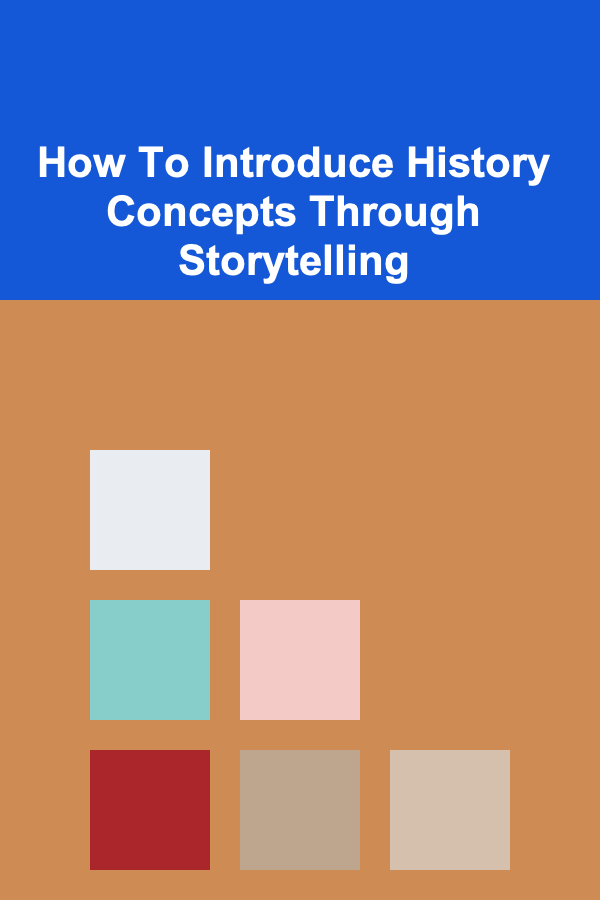
How To Introduce History Concepts Through Storytelling
ebook include PDF & Audio bundle (Micro Guide)
$12.99$10.99
Limited Time Offer! Order within the next:

History is often seen as a subject of dates, names, and events---facts that can sometimes feel disconnected and dry. However, at its core, history is the story of human experience. It's about the decisions, actions, and struggles of individuals and groups who shaped the world we live in today. When we approach history with a storytelling mindset, we not only make it more engaging but also enable learners to connect more deeply with the content. Through compelling narratives, history can transcend memorization and become an exploration of ideas, cultures, and the human condition.
In this article, we'll explore how to effectively introduce history concepts through storytelling. We'll cover the essential elements of storytelling, the role of narrative in learning, strategies for incorporating storytelling into history lessons, and the impact it has on engagement and comprehension. By the end, you will have a deeper understanding of how history and storytelling can work together to captivate audiences and impart essential historical knowledge.
The Power of Storytelling in History
Before delving into how we can use storytelling to introduce history concepts, it's important to first understand why storytelling is such a powerful tool in learning.
Emotional Connection
At its core, storytelling elicits an emotional response from the audience. It taps into our empathy, allowing us to connect with historical figures and events on a more personal level. This emotional engagement leads to better retention, as learners are more likely to remember stories that evoke feelings of wonder, surprise, anger, or joy. For example, stories about the lives of everyday people during the Great Depression or the hardships faced by immigrants in the 20th century often resonate with listeners on an emotional level, making the history of these events more relatable.
Simplification of Complex Ideas
History is filled with complex ideas, theories, and ideologies. Narratives help break these down into digestible and relatable pieces. Storytelling helps contextualize complex concepts by tying them to specific characters or events, making them easier to understand and retain. For example, a story about the Industrial Revolution can explain technological advancements, economic theories, and social changes, all through the lens of a specific person's journey or experience.
Engaging the Imagination
Humans have an innate attraction to stories. From ancient myths and epics to modern films and books, storytelling has been a universal method of transmitting knowledge. When history is told as a story, it activates the imagination of learners, allowing them to envision themselves in the historical context. This immersive quality of storytelling makes historical concepts come alive. Instead of passively absorbing facts, learners are placed into the historical scene, experiencing it as if they were there themselves.
Creating a Cohesive Narrative
Storytelling allows history to be framed as a narrative rather than a list of isolated events. Instead of simply memorizing dates and facts, learners can follow a continuous thread of cause and effect, understanding how one event led to another. This helps students see history as a dynamic process rather than a static collection of events. For example, by telling the story of World War II through the personal experiences of soldiers, civilians, and world leaders, we can create a more coherent understanding of the war's global impact and long-lasting consequences.
Key Elements of Storytelling in History
To effectively introduce history concepts through storytelling, it's essential to understand the key components that make a story engaging and informative. While historical narratives may not always follow the structure of fiction, they still rely on the same storytelling techniques.
1. Characters
At the heart of every good story is a compelling character. In history, these characters could be famous figures like Cleopatra, Napoleon, or Martin Luther King Jr., or they could be everyday people whose stories have been overlooked. The key is to choose characters whose experiences illustrate important historical themes or concepts. By focusing on individuals, students can more easily relate to the broader historical context.
For example, when teaching about the American Revolution, instead of just listing the causes and effects, focus on a character like Abigail Adams, who not only experienced the events of the revolution but also contributed to the conversation about women's rights and independence. This personal perspective offers a more nuanced understanding of the era.
2. Setting
The setting of a story---the time, place, and culture---plays a critical role in shaping the historical narrative. Just as in fiction, the setting in historical storytelling provides the context for understanding the events. Whether it's the bustling streets of Paris during the French Revolution or the quiet farms of rural America during the Civil War, the setting immerses the audience in the world of the story, helping them visualize and understand the conditions that shaped the events.
It's crucial to create a vivid mental picture of the time and place in which the story takes place. This might involve descriptions of clothing, architecture, food, and social customs, which can provide insights into the values and struggles of the people living in that period.
3. Conflict
No story is complete without conflict. In history, conflict can take many forms: political struggle, war, social unrest, or internal personal conflict. Conflict is what drives change, and understanding the nature of historical conflicts helps students grasp the forces that shaped the course of history.
For example, the story of the civil rights movement in the U.S. is not just about peaceful protests; it's about the deep conflict between systemic racism and the quest for equality. By telling the story through the experiences of activists like Rosa Parks or Malcolm X, learners can better understand the intense personal and societal struggles that fueled the movement.
4. Plot and Structure
While history may not always follow the linear, neatly structured format of fiction, it can still be presented as a series of events with cause and effect. The plot of a historical story doesn't just involve a collection of isolated events but the interconnectedness of those events. For instance, the story of the fall of the Roman Empire can be framed as a narrative about the slow decline, internal strife, and external invasions that led to its collapse.
By structuring historical events in the form of a story, students can better grasp how different events interrelate. They can see how actions in one period might set the stage for the next, making history feel like a continuous, evolving narrative rather than a series of disconnected moments.
5. Themes
Like any good story, historical storytelling is about more than just the events---it's about the deeper themes that these events represent. Whether it's the theme of freedom in the American Revolution, the theme of resistance in the fight against apartheid, or the theme of innovation during the Renaissance, storytelling allows students to explore universal concepts that transcend specific historical periods.
By highlighting these themes, history lessons can resonate more deeply with learners, showing them how these ideas continue to shape the present and future.
Strategies for Introducing History Concepts Through Storytelling
Now that we understand the power of storytelling and the elements that make a compelling historical narrative, let's look at some practical strategies for introducing history concepts in this way.
1. Use Primary Sources to Tell Stories
Primary sources---letters, diaries, photographs, speeches---are a goldmine for storytelling. These firsthand accounts allow students to hear the voices of people who lived through the events. Instead of simply telling students about the Boston Tea Party, give them a letter written by someone involved in it, or a newspaper article from that time. This brings the history to life and provides a personal touch that secondary sources may lack.
2. Focus on Personal Stories
While broad historical events are important, focusing on personal stories can create a more intimate connection to history. Stories about the experiences of ordinary people---whether they're soldiers, factory workers, or slaves---allow students to understand history from a human perspective. Personal stories make historical events more accessible and relatable, encouraging empathy and deeper learning.
3. Incorporate Drama and Role Play
Encourage students to get involved in the storytelling process by using drama or role-play. By assuming the roles of historical figures or everyday people, students can engage with history in a more interactive and dynamic way. This hands-on approach allows learners to experience history as if they were living it themselves, providing a deeper understanding of the challenges faced by people in the past.
4. Create a Narrative Arc
When introducing historical concepts, it's helpful to present them as part of a larger narrative arc. This might mean starting with an event and leading students through the buildup of tensions, the climax of the event, and its aftermath. For example, instead of just recounting the causes of World War I, take students through the tension-filled years leading up to the assassination of Archduke Franz Ferdinand, the alliances that were formed, and the devastating consequences of the war.
5. Use Visuals and Media
Images, maps, videos, and even podcasts can enhance the storytelling experience. Visuals help students contextualize the events they're learning about, adding another layer of engagement. For example, showing a video of the Berlin Wall's fall can help students visualize the emotional impact of the event, while photographs from the Civil Rights Movement can give a human face to the struggles of the time.
The Impact of Storytelling on Learning History
By incorporating storytelling into history lessons, students not only learn the facts but also develop a deeper understanding of the human experiences that shaped those facts. Storytelling fosters critical thinking, empathy, and emotional engagement, all of which are essential for making history more than just a subject to be studied---it becomes a lens through which we understand the world.
Moreover, storytelling provides a framework for students to connect historical events with contemporary issues. It helps them see that history is not just a collection of past events, but a living, breathing process that continues to influence us today. Through storytelling, history becomes not just something we study, but something we live and feel.
Conclusion
Introducing history concepts through storytelling is one of the most powerful and effective ways to engage learners. By focusing on characters, setting, conflict, and themes, history becomes a vibrant narrative rather than a dry list of facts. The emotional connections formed through storytelling help students retain knowledge and develop a deeper understanding of the past.
As educators, historians, or simply lovers of the past, we have the opportunity to transform history into a compelling story that both educates and inspires. By employing storytelling techniques, we can ensure that history resonates with future generations, allowing them to connect with the struggles, triumphs, and lessons of the past.
Reading More From Our Other Websites
- [Skydiving Tip 101] First-Time Skydiver's Guide: Step-by-Step from Ground to Freefall
- [Personal Care Tips 101] How to Use Body Lotion for a Post-Workout Skin Recovery
- [Home Renovating 101] How to Choose the Perfect Flooring Installation Guide for Your Home
- [Home Renovating 101] How to Update Your Front Door for a Stylish Welcome
- [Personal Finance Management 101] How to Pay Off Debt Using the Snowball Method
- [Skydiving Tip 101] The Psychology of the Plunge: What Drives Thrill-Seekers to Leap from the Sky
- [Mindful Eating Tip 101] A Day on the Plate: A Mindful Eating Journal to Track and Conquer Cravings
- [Scrapbooking Tip 101] Quick Layout Hacks: Using Grid Lines, Templates, and Color Schemes for Flawless Pages
- [Gardening 101] How to Start a Thriving Vegetable Garden in Your Backyard
- [Home Soundproofing 101] How to Create a Quiet Space for Your Dog with the Best Soundproofing for a Crate

How to Keep Track of Assignments and Due Dates Effectively
Read More
How to Keep Your Home Clean While Remodeling or Renovating
Read More
How to Plan Lighting for Your Home Renovation Project
Read More
How to Set Up a Checklist for Addressing Areas of Improvement During Your Performance Review
Read More
How to Use Technology to Aid Weight Loss
Read More
How to Read Food Labels for Weight Loss Success
Read MoreOther Products

How to Keep Track of Assignments and Due Dates Effectively
Read More
How to Keep Your Home Clean While Remodeling or Renovating
Read More
How to Plan Lighting for Your Home Renovation Project
Read More
How to Set Up a Checklist for Addressing Areas of Improvement During Your Performance Review
Read More
How to Use Technology to Aid Weight Loss
Read More